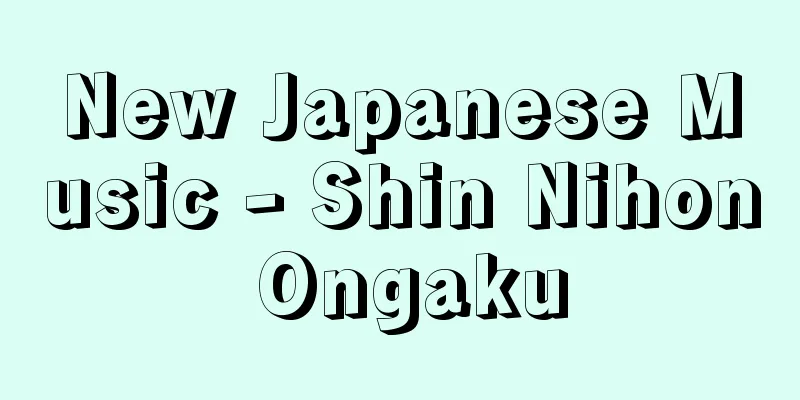New Japanese Music - Shin Nihon Ongaku

|
A general term for the music movement from the mid-Taisho period to the early Showa period, and the compositions that emerged from that movement. The group was centered around Miyagi Michio, a koto player, and his collaborator Yoshida Seifu, a shakuhachi player. While rooted in the traditions of Japanese music, it also incorporated elements of Western music, aiming to create new Japanese music that transcends the boundaries of genres and schools. The name originated from a joint presentation of works by Miyagi Michio and Motoori Nagayo (a Western composer) held at the Yurakucho Theater in Tokyo on November 27, 1920, which Yoshida suggested be titled the "Grand Concert of New Japanese Music." Motoori soon left the group, but there were many sympathetic people seeking a new style in the Japanese music world, including Nakao Tozan I, a Tozan-ryu shakuhachi player, Kanamori Takayama, koto player Nakajima Gagaku No Miyako, researchers Tanabe Naoo, and Machida Keisei, who participated in the movement, published compositions, and worked to perform and educate the public. Miyagi's works are representative in terms of quantity and quality. After radio broadcasting began in 1950, the name "New Japanese Music" was given to new compositions by Miyagi and others as if it were a genre of music, and the name became established. Many of the compositions were instrumental, ranging from solo to large ensembles, and the main instruments used were the koto, shamisen, and shakuhachi, but other Japanese and Western instruments were also used, and newly invented instruments were also created. Among them, the 17-string koto invented by Miyagi became established as a low-pitched Japanese instrument, and it still plays an important role in modern Japanese music today. In terms of incorporating Western music, it was limited to classical forms, functional harmony, canon form, and other forms that were easy to incorporate into Japanese music. From around 1955, even the proponents themselves began to use the name "New Japanese Music" less and it came to be included under the broader name "New Japanese Music." Source: Encyclopaedia Britannica Concise Encyclopedia About Encyclopaedia Britannica Concise Encyclopedia Information |
|
大正中頃から昭和初期にかけての音楽運動,およびその運動から生れた楽曲の総称。箏曲家の宮城道雄とその協力者で尺八家の吉田晴風が中心。邦楽の伝統に根ざしつつ,洋楽の要素も摂取し,種目,流派の枠をこえた新しい邦楽を目指す。名称は,1920年 11月 27日東京有楽座で催された宮城道雄と本居長世 (洋楽の作曲家) との合同作品発表会を,吉田の発案により「新日本音楽大演奏会」と銘打ったことに始る。本居はまもなく離脱したが,邦楽界の新気風を求める共鳴者は多く,都山流尺八家の1世中尾都山,金森高山,箏曲家の中島雅楽之都,研究家の田辺尚雄,町田佳聲らが運動に参加し,作曲を発表し,演奏や啓蒙に努めた。作品としては,宮城のものが量的質的に代表的。 25年ラジオ放送開始後は,宮城らの新曲には「新日本音楽」の名があたかも種目名のごとくに冠され,名称が確立するにいたった。楽曲は独奏から大合奏まで含む器楽曲が多く,楽器は箏,三味線,尺八が主流をなすが,他の邦楽器や洋楽器をも用い,また新考案の楽器も生み出した。なかでも宮城の考案による十七弦は低音邦楽器として定着し,現在でも現代邦楽のなかで重要な役割をになっている。洋楽摂取の面では古典的形式,機能和声法,カノン形式など邦楽に取入れやすいものに限られる。 30年頃からは,提唱者自身も「新日本音楽」の名をあまり用いなくなり,より広い範囲をさす「新邦楽」の名のもとに包括されるようになった。
出典 ブリタニカ国際大百科事典 小項目事典ブリタニカ国際大百科事典 小項目事典について 情報 |
<<: Nippon Steel Corporation - Shinnihon Seitetsu
>>: Shinnanyo [city] - Shinnanyo
Recommend
Andrey Rublyov
A Russian painter-monk. He was the greatest paint...
Cambyses [II] - Cambyses
King of the Achaemenid Empire of Persia (reigned 5...
Argentoratum - Argentoratum
…In addition to the museum that houses Italian, F...
Antoine de Montchrestien
Around 1575 - 1621 French dramatic poet and econom...
Manifold - Manifold
A topological space modeled on Euclidean space is...
Fugitive - Ochiudo
Kabuki dance drama. Kiyomoto. The original title ...
Yakazu Haikai
A form of haikai. Modeled on the archery competit...
Houoka ruins (English name)
The site is located in the northwest of Anyang Cit...
Bernard Malamud
American novelist. Born in Brooklyn, New York to ...
El Paso
A city in the western tip of Texas, U.S.A. Populat...
Kungsan yujŏk (English name)
Located in Unha-ri, Oncheon-gun, South Pyongan-do,...
Yamabushi - Yamabushi
A religious leader of Shugendo. A religious perso...
Mr. Ishikawa
A Fudai Daimyo family in the Edo period. Its ance...
Ceratium longipes (English spelling) Ceratium longipes
… [Minoru Imajima]. … *Some of the terminology th...
Daphne genkwa (English spelling) Daphnegenkwa
… [Toshio Hamatani]. … *Some of the terminology t...









